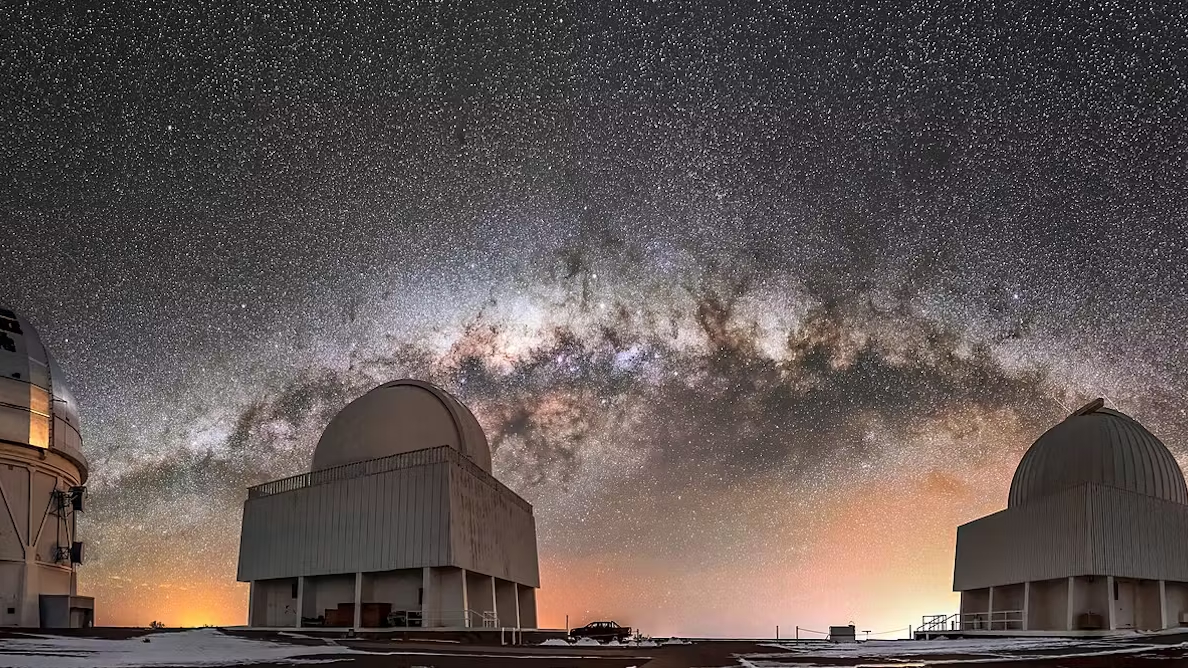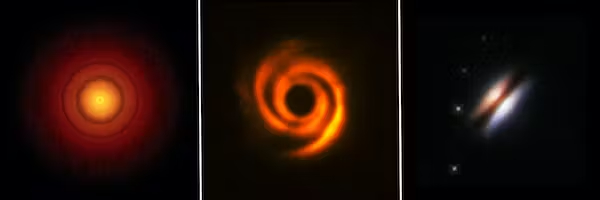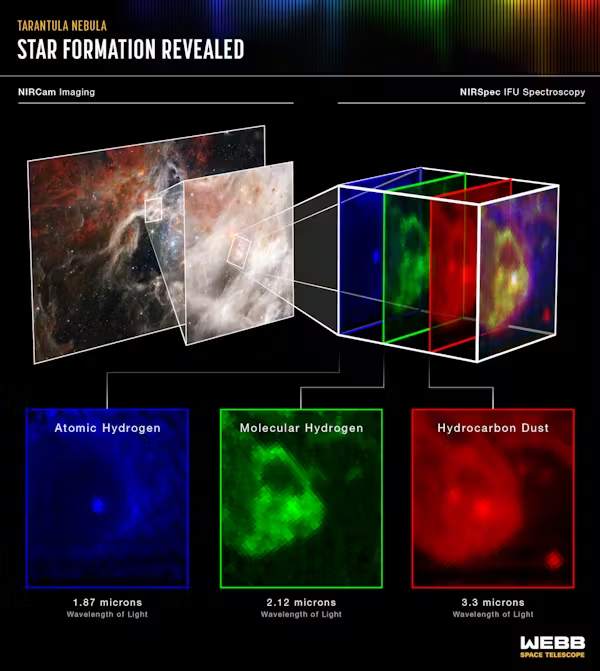
Astronomers have learned lots about the universe − but how do they study astronomical objects too distant to visit?
What astronomers can measure using telescopes is not what we really want to know – instead, we calculate the properties we're interested in studying by observing and interpreting apparent properties from afar.

This article was originally published at The Conversation. The publication contributed the article to Space.com's Expert Voices: Op-Ed & Insights.
Luke Keller is a Professor of Physics and Astronomy at Ithaca College and has received funding from NASA.
NASA's OSIRIS-REx spacecraft flew by Earth on Sept. 24, 2023, dropping off its sample of dust and pebbles gathered from the surface of near-Earth asteroid Bennu.
Analysis of this sample will help scientists understand how the solar system formed and from what sorts of materials. Scientists will begin their analysis in the same facility that analyzed rocks and dust from the Apollo lunar landings.
As an astronomer studying how planets form around distant stars, I felt excited watching the broadcast of that Bennu sample descending to the Utah desert – and a little envious. Those of us who study distant young solar systems can’t send robotic spacecraft to get a closer look at them, let alone grab a sample for laboratory analysis. Instead, we rely on remote observations.
But what astronomers can measure using telescopes is not what we really want to know – instead, we calculate the properties we're interested in studying by observing and interpreting apparent properties from afar.
Related: NASA's 1st asteroid sample is rich in carbon and water, OSIRIS-REx team finds
Get the Space.com Newsletter
Breaking space news, the latest updates on rocket launches, skywatching events and more!
Astronomers' tools
Asteroids are like fossils – they're composed of rocky material from the formation and early evolution of a solar system and they are preserved nearly unchanged. That’s how the pristine Bennu samples will help astronomers learn about our solar system’s formation.
Over the past several decades, astronomers have learned that disks of gas and dust called protoplanetary disks orbit young stars. Observing these disks – located many light years outside our solar system – can help astronomers understand the early planet formation process, but they’re too distant to send a sample-return mission like OSIRIS-REx to directly measure what the dust and asteroids in these systems are made of.

All that astronomers like me can do is observe those distant regions of the universe remotely, using telescopes here on Earth or in orbit near Earth. But even with limited tools and techniques, we’ve still managed to learn quite a bit about them.
Distance and luminosity
The closest protoplanetary systems are a few hundred light years from the sun, but we can’t directly measure distances that large. Instead, we have to determine distance indirectly using precise measurements of parallax – small changes in the apparent position of the star caused by our changing perspective as Earth orbits the sun.
Once we know their distances from Earth, we can determine another essential physical property of protoplanetary disks: Their luminosities and the luminosities of their stars.
Luminosity is an object’s power output measured in watts. The luminosity of a star like our sun is in the hundreds of trillions of trillions of watts. Just as sunlight influences weather and the chemistry of planetary atmospheres in our solar system, the luminosity of a young star directly affects the material in its protoplanetary disk. Luminosity can alter the size and composition of dust particles that will later form asteroids and planetary cores.
But brightness does not directly indicate luminosity. The measured brightness of a star or any luminous object decreases with the square of its distance from us. We measure the apparent brightness of a star, or how bright it looks in a digital image, and then calculate its luminosity from this observed brightness and the star's distance.
Color and temperature
Luminosity also depends on temperature – warmer objects are usually more luminous – but we can't directly measure the temperatures of distant systems. Astronomers determine temperature using precise measurements of the apparent color of a star and of the gas and dust orbiting in its planet-forming disk.
The color images of celestial objects that you see from observatories like the Hubble or James Webb space telescopes are composites of multiple images taken through a series of colored filters.

For astronomers, colors are numbers describing the brightness of an object at a particular wavelength compared with its brightness at another wavelength. Warmer objects emit more blue light relative to red light, so their color looks more blue and the corresponding number is smaller. Astronomers measure color in even more detail by passing starlight through a small prism installed in the telescope’s camera. This prism disperses the light into a spectrum.
The spectrum of light from a star and its surrounding material isn’t a smooth rainbow of color. Sharp bright and dark features in the spectra indicate the presence and relative abundances of atoms, molecules and even minerals. These chemical elements emit or absorb light in unique and recognizable combinations of colors.
Measurement and interpretation
Can you see a theme emerging? Astronomers can measure only a handful of apparent properties: brightness, color, position in the sky, shape, angular size and how each of these changes with time. These are the same properties each of us measures with our senses to navigate our surroundings in everyday life. They’re nothing exotic or special.
And yet everything astronomers know about distant solar systems and their formation we have derived from measurements of these familiar and unremarkable apparent properties. The rich and detailed descriptions that we've come to expect in astronomy and astrophysics come from applying our understanding of chemistry and physics to these measurements.
The arrival of the Bennu sample is exciting because it is "real." In the coming months and years, scientists will examine this dust to inform our studies not only of asteroids and interplanetary dust, but also of interstellar dust in solar systems farther afield. I am eager to see what these new details will teach us about cosmic dust, some of the primary building blocks of planets everywhere.
This article is republished from The Conversation under a Creative Commons license. Read the original article.
The views expressed are those of the author and do not necessarily reflect the views of the publisher.
Join our Space Forums to keep talking space on the latest missions, night sky and more! And if you have a news tip, correction or comment, let us know at: community@space.com.

Luke Keller is an award-winning Professor of Physics and Astronomy at Ithaca College. He is author or co-author of over 40 peer-reviewed journal articles reporting studies of star formation, planet formation, optics, and development of instrumentation for large astronomical observatories. He has gathered over a million dollars in funding for his research from NASA, the NSF, and the Research Corporation for the Advancement of Science. He served on the team that designed and built an infrared camera for the Stratospheric Observatory for Infrared Astronomy for which he received a NASA Group Achievement Award. In parallel with his scientific research and engineering work he has written articles and essays for science communication to the general public and has worked on several projects integrating science with art and performance. His current such project is The Effects of Gravity, a stage performance combining equal parts astrophysics, poetry, and music.
-
YetAnotherBob Reply
They use telescopes, obviously. Those are historically, Optical, since the 1950's radio wave and most recently, Infrared and ultraviolet, along with limited x-ray and now gravity wave devices.Admin said:What astronomers can measure using telescopes is not what we really want to know – instead, we calculate the properties we're interested in studying by observing and interpreting apparent properties from afar.
Astronomers have learned lots about the universe − but how do they study astronomical objects too distant to visit? : Read more
Quite a lot has been learned too.
One problem is that the farther away you look, the less you are able to see small details. For observations of Jupiter for instance, from Earth it's hard to make out details much smaller than the state of Texas, or the nation of Switzerland. To learn much more, we had to send satellites there to look from closer up.
So we are in something of a quandary. There is a lot to learn and a lot has been learned. But it's become expensive and more and more removed from ordinary life. Selling the results as "Science" is becoming harder to do as well.
The value of science comes from it's ability to allow us to predict what will happen if we do something or don't do it. This is what makes possible all of our technology. It has gone on since the ancient Sumerians figured out that mixing straw with mud and then drying it made bricks which could be used to build houses and walls. It made several of the ancient civilizations, and an extension of it has made us almost able to colonize the Moon and Mars.
Almost...
For interstellar distances, it's hard to see something as small as a planet. This limits us. For now.









